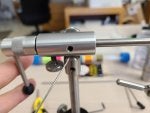I am having movement between the shaft adapter (#12) and bearing housing (#1) in my Barracuda Junior. There aren't really instructions available online and I can't figure out how to get these pieces tight to each other. I have included a picture where the dubbing needle is showing the location of movement. It appears to unscrew here maybe? Thoughts. I have also attached the schematic to show the pieces I am mentioning. Thanks all.
Scott
Scott





